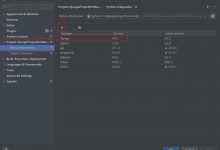一,什么是jinja2模板引擎
jinja官网:
Jinja is a modern and designer-friendly templating language for Python,modelled after Django’s templates. It is fast, widely used and securewith the optional sandboxed template execution environment:
特点:
相对于DTL(官方文档,也可以参考这篇文章}而言,jinja2更加性能高效、文档可读性也更高。
二,安装与配置
1,安装


2,配置
1,直接在settings.py中添加模板配置就行,不必删除内置的DTL的配置,否则可能会导致内置功能因为没有模板引擎而无法使用。
TEMPLATES = [{\'BACKEND\': \'django.template.backends.jinja2.Jinja2\',\'DIRS\': [os.path.join(BASE_DIR, \'index/templates\'),os.path.join(BASE_DIR, \'templates\'),],\'APP_DIRS\': True,\'OPTIONS\': {\'environment\': \'messageBoard.jinja2.environment\',},},{\'BACKEND\': \'django.template.backends.django.DjangoTemplates\',\'DIRS\': [],\'APP_DIRS\': True,\'OPTIONS\': {\'context_processors\': [\'django.template.context_processors.debug\',\'django.template.context_processors.request\',\'django.contrib.auth.context_processors.auth\',\'django.contrib.messages.context_processors.messages\',], },},]
2,全局使用jinja2模板
在项目同名目录中添加jinja2.py文件,该文件用于将jinja2模板加载到整个项目。
文件中需要实例化Environment类。
from django.contrib.staticfiles.storage import staticfiles_storagefrom django.urls import reversefrom jinja2 import Environmentdef environment(**options):env = Environment(**options)env.globals.update({\'static\': staticfiles_storage.url,\'url\': reverse,})return env
3,验证是否能正常使用
views.py:def index(request):context = {\'value\': \"这是jinja2\"}return render(request, \'index.html\', locals())index.html:<!DOCTYPE html><html><head><link rel=\"shortcut icon\" href=\"#\"/><title>Jinja2</title></head><body><div>{{ context[\'value\'] }}</div></body></html>

三,模板语法
jinja2中文手册
 爱站程序员基地
爱站程序员基地


